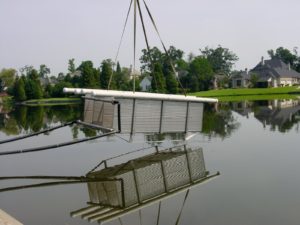
A Slim Jim® 40 ton (HR) “POND LOOP IN A PACKAGE” consisting of four SJ-10T plates assembled with frame on skids, 3″ manifold and 3″ flange connections. Courtesy photo.
By George Harvey
Alan Watts had seven years’ experience in heating and cooling when he designed his first geothermal project in 1981. It was a simple system, with open discharge on a water well, but it had a profound effect.
“Once I did that one system,” Watts said, “it kind of bit me, and I’ve been involved ever since.”
Green Energy Times now has published numerous articles on geothermal heating. One dealing with water as a heat source, “Geothermal Heat Pump with a Pond Loop,” appeared in April, 2015. (http://bit.ly/GET-pond-loop)
In a pond loop system, a heat pump extracts heat from the water, though it may be cold, and releases it into the building being heated. It is rather like the system we all know that extracts heat from inside a refrigerator releases it into the kitchen. The units heating buildings, however, can usually be run for air conditioning as well.
There are several kinds of heat pumps. They are among the most efficient systems available for heating and cooling, and the least expensive to run. Geothermal heat pumps are much more efficient and inexpensive to run than air-source heat pumps. Those using surface water as the heat source are the simplest and least expensive geothermal systems to install. The only thing that can obviously beat such a unit for low pollution and operating cost is not heating or cooling at all.
Alan Watts saw clearly the advantages of geothermal systems from the start. Increasingly, he focused his attention on them, and he established AWEB Supply in 1984. Within only a few years, he became a distributor of geothermal equipment for a major manufacturer and began establishing a network of geothermal dealers by working with and assisting in design of systems.
The heat pump may be the core component of its system, but the heat exchanger that extracts heat from the environment is equally vital. Watts first supplied ClimateMaster and then WaterFurnace heat pumps, which are carefully engineered and manufactured systems. But he could see that the heat source, in the ground or the water, requires special, local expertise for any installation to be of the highest quality. As good as the systems using surface water as heat sources were, there were shortcomings that Watts was aware of. He wanted to make geothermal simple and labor-friendly.
Conventional technology had systems made of plastic because of its ability to hold up in the environment. Plastic, however, is a poor heat conductor. Because of this, the heat exchangers in the water had to be large, usually consisting of many loops of semi-flexible pipe which made them cumbersome and labor intensive, and difficult to install. They also had large surface areas, so silt could easily build up on them, reducing their efficiency with time. And this meant that they had to be lifted off the bottom every few years to have the silt washed off.
Watts’ moment of illumination came as he saw clearly a better way. And with his new understanding, the Slim Jim® and Geo Lake Plate® systems were born, introduced in 1999.
Watts’ new approach was to make the AWEB Slim Jim® heat exchangers out of 304 stainless steel. For more corrosive sites such as salt water, where there could be corrosion issues, the Geo Lake Plate® systems are made out of titanium. These metals have high thermal conductivity, so the systems made from them can be much more compact and easier to install. They stand vertical and give silt no opportunity to get in the way. For specialty applications, Geo Lake Plate® is available in 316L Stainless.
Because the AWEB Supply heat exchangers are made of stainless steel or titanium, they are a little more expensive than the plastic exchangers they replace. But the beauty of the systems can be seen when the overall cost of installation is calculated. Because they are compact, with relative ease of installation, the overall cost of the system is reduced at installation. They are also less expensive to maintain.
There are numerous examples of Watts’ systems, both in the United States and elsewhere. The largest Slim Jim® system installed, believed to be the largest of its kind in the world, was at Nashville International Airport. The airport expected to save $400,000 per year on air conditioning but found it was doing much better, possibly double that amount (http://bit.ly/NIA-AC).
AWEB Supply has discontinued distribution of heat pump equipment and supplies so they can concentrate their energies on making Geo-Exchange “As Simple as It Gets!” with the Slim Jim® and Geo Lake Plate® exchangers.
AWEB Supply’s web site is http://www.awebgeo.com. You can view their ad on the back page.








Leave a Reply